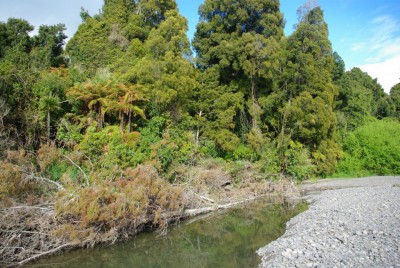Exotic Bitter Willow (Salix eleagnos): A Paradoxical Opportunity to Restore Shade-Tolerant Native Species?

The invasive exotic tree bitter willow (Salix eleagnos; Salicaceae) was naturalised in New Zealand in 1968; being native to central and southern Europe and south west Asia; and today the species colonises riparian margins and wet soils in many regions of New Zealand1. The tree is deciduous, has a stature of around 5 × 5 m, is low- and multi-branched, and through vigorous vegetative spread, the species invades open areas to form exotic forest stands.

Riparian exotic invasive bitter willow (Salix eleagnos), Central Hawke's Bay, New Zealand
Observations of the tree’s ecology suggest that bitter willow is a light-demanding coloniser, colonising high-light environments, developing a dense canopy cover, which casts heavy shade. The shade cast by bitter willow has been observed to outcompete light-demanding plant-pest species, such as tree lupin (Lupinus arboreus) or blackberry (Rubus fruticosus agg.). Importantly, bitter willow has been found to exclude light-demanding exotic grass species, meaning development of a highly-competitive exotic-grass sward is precluded. The resulting shaded understorey has been found to be largely free of light-demanding competitors, and mineral soils are available for the establishment of shade-tolerant flora.

Titoki (Alectryon excelsus) seedling established under the shelter of bitter willow
Since 2012 Forbes Ecology has been monitoring forest regeneration within manipulated stands of bitter willow, located on silty soils in a riparian position. The bitter willow canopy was experimentally opened, by poisoning individual trees, to locally increase light transmission, with the aim of increasing regeneration of native forest species.

Example of experimental canopy manipulation within an exotic bitter willow stand
Several years on from canopy opening, the monitoring results show that where canopy interventions have been carried out, marked increases have resulted in the density of native forest canopy species, such as: titoki (Alectryon excelsus), matai (Prumnopitys taxifolia), kahikatea (Dacrycarpus dacrydioides), and totara (Podocarpus totara). Thus, it appears that the shelter provided by the exotic invasive species is adequate to facilitate the establishment of native canopy species. This suggests the willow is filling the role of native seral nurse crops, such as manuka/kanuka (Leptospermum/Kunzea), or native shrub-hardwood species.
Further, monitoring carried out to date suggest that mammal browse of seedling regeneration within the low-branching, dense stature of the bitter willow stands is low to non-existent, and this is despite deer sign being detected in open areas and areas of river bed close to the site. This suggests that the dense stature serves a protective function, preventing access by deer, and other grazing mammals.

Dense native podocarp and broadleaved seedling establishment beneath manipulated (opened) bitter willow canopy
Thus, at the trial site, bitter willow presents somewhat of a paradox – where an exotic invasive species fills a nursery role in a native forest succession, and facilitates the establishment and potential recruitment of native forest canopy species. This presents novel questions and opportunities for management. In these predominantly weedy riparian zone ecosystems, which typically have a history of disturbance and colonisation by pioneer exotic floral species, and where shade-tolerant canopy species are typically left without suitable niche for establishment, the results of the trial suggest further consideration should be given to the use of the exotic invasive bitter willow for the facilitation of native canopy tree species.
Outright clearance of the bitter willow canopy would effect what is essentially a catastrophic disturbance at the stand level, and would result in high-resource availability, and thus would tend to lead to dominance by light-demanding plant pest species, at the expense of opportunities for successional development of shade-tolerant native forest flora. Perhaps then, compared to complete clearance of the bitter willow canopy, methods of retaining the benefits of shade and shelter afforded by the bitter willow stands would provide a more sensible restoration strategy? Canopy manipulations to stimulate native forest seedling regeneration, thus transitioning stands to native dominance over time, is one option requiring further consideration. This option would need to be balanced with the risk of further invasive spread of bitter willow.

Titoki (Alectryon excelsus) under manipulated (opened) bitter willow canopy
Monitoring results collected to date are currently being analysed and reported, with the intention of publication during 2016. If you wish to know more about this trial, or would like to be kept informed of progress of the trial, please contact Dr. Adam Forbes for further information.
Biodiverse, is the Forbes Ecology Blog. You are able to follow this blog by entering your email address here. You can unsubscribe at any time.
References:
1 http://www.nzpcn.org.nz/flora_details.aspx?ID=2984